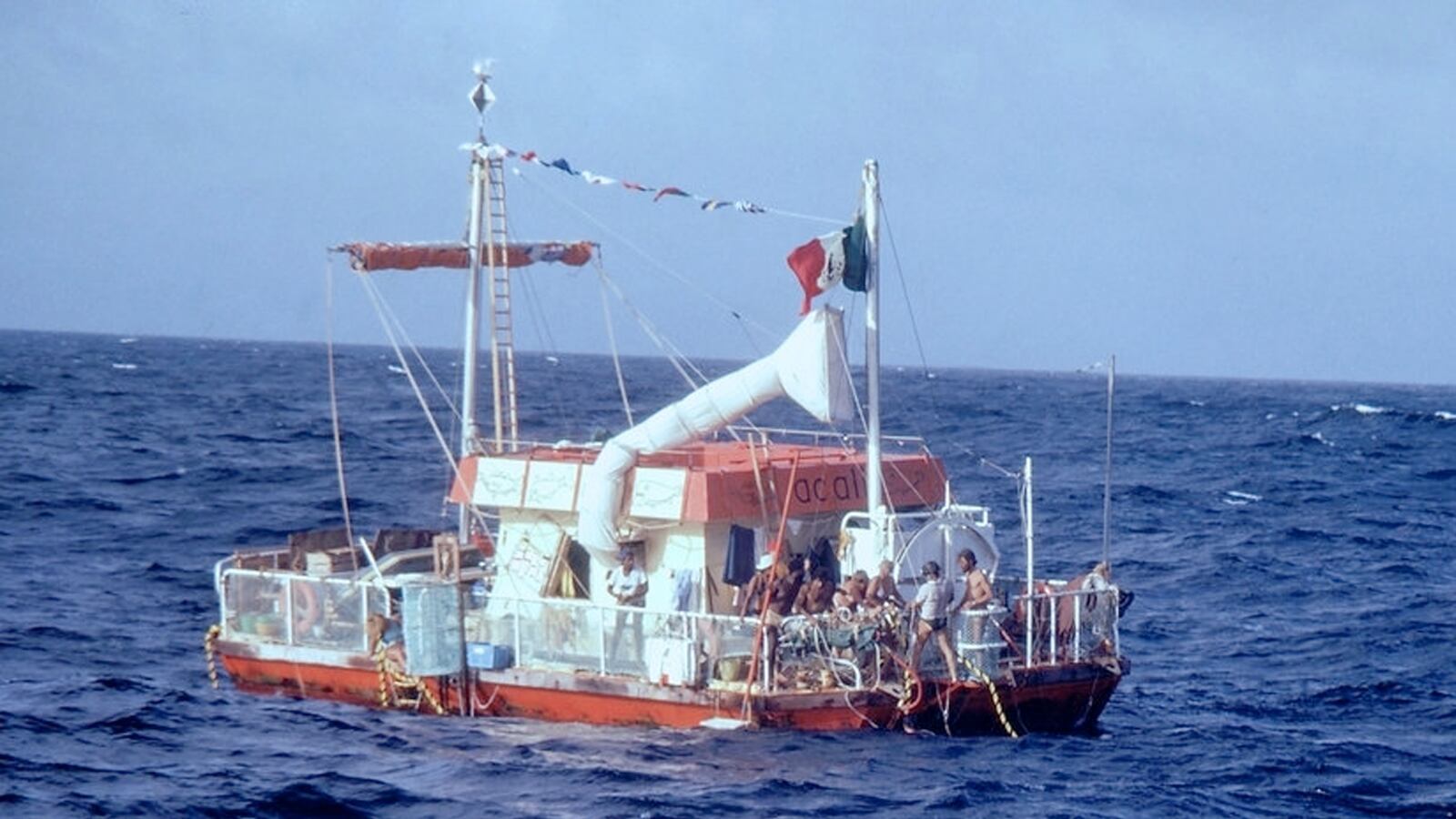LONDON—It was one of the most notorious science experiments of the 1970s, but only now has a documentary lifted the lid on what really happened on the notorious “sex raft.”
Dr. Santiago Genovese set sail in 1973 hoping to study the interactions of 11 strangers from different countries, races, religions and languages who were confined to a tiny raft as it floated across the Atlantic for 101 days.
What transpired was an extraordinary demonstration of the human spirit—including sex, furious arguments and deep friendship—that confounded all of the scientist’s expectations. The documentary The Raft, which is up for the Grierson Award for Best Documentary at the London Film Festival, reveals that by the end of the trip, Santiago’s human guinea pigs were also secretly plotting his murder.
The anthropologist came up with the experiment after his flight was hijacked on the way home to Mexico City from a conference on the history of violence.
Amid life-and-death tension as the passengers feared they would never see their families again, he felt he was witnessing true emotions and reactions and “realized this was perfect conditions for experimenting on human behavior.”
The Mexican professor tried to recreate those fraught hijacking conditions on a boat drifting across the Atlantic. He hoped that an orgy of sex and violence would break out on the isolated vessel as it made an unprecedented and dangerous three-month journey across the ocean. He imagined this would give him the opportunity to observe humanity’s most primal interactions and give him insight into creating a more peaceful society.
There was indeed sex on the high seas but Santiago’s efforts to stir up conflict fell flat. He tried to incite disputes between his volunteers by staging moments of tension, revealing what they had said about each other, and even by risking their lives in a hurricane. None of it worked.
As he had explained to the media before the mission began, he believed violence was most likely to erupt from tensions over sex. Santiago went to increasingly obvious lengths to encourage his charges to make love. “Of course Santiago wanted sexual things to happen,” explained Rachida Lièvre.
Edna Reves, the Israeli doctor on the boat, said she had sex with two of the men on board. She wasn’t the only one, but sex was quite rare as some of the other women refused to be drawn into the free-love attitude of Santiago’s fevered expectations.
One of the scientist’s mistakes on this front was in the communal design of the raft, which meant even the toilet was visible to the rest of the shipmates.
“It was complicated to have sex on the raft because other people could always see you,” said Edna. “Maybe if two people were on guard together and you were a little bit quick, then it was possible but it was tricky because you had to use one of your hands for steering.”
Santiago had given all of the positions of authority to women in the crew, from captain to doctor and scuba diver. He hoped this would be another point of conflict for his charges. “Will the men become frustrated with the women in power and slowly try to take over?” he wondered.
The answer first became apparent when a minor repair was required just below the water level on the outside of the boat. The macho scientist declared that the task was too dangerous for the trained scuba diver and he took to the water himself. After flailing around unsuccessfully, the boatmates dragged Santiago back on deck. He resolved to try again the following morning, but a few of the women got up before him and quickly completed the work before he woke.
“He was so pissed off!” said Edna. “Part of the experiment was to put women in important positions… but because of his personality, he couldn’t take it.”
Santiago became more belligerent as he tried to regain authority. “He started acting like a dictator,” said one of the women. Another complained about his “Gestapo methods.”
Santiago’s frustration was apparent as the crew on his boat refused to act as he had envisioned—either in terms of sex or violence. The voyage was already insanely dangerous; the boat had no motor, no support vessels and no means to survive the Caribbean hurricane season they were bobbing directly into.
They were captained by Maria Björnstam, a Swede who had recently become one of the world’s first women to qualify as a ship’s captain.
She was skeptical of the mission but accepted the job after they were unable to find any other female captains. As Santiago explained, she still didn’t buy his ideas. He recounted one frosty group meal on the boat when Maria demanded to know what they were there for. “I told them that I wanted to find a way to make peace on Earth,” he said. “She just rolled her eyes.”
After a slow start put them on course for dangerous weather systems, Maria declared the voyage to be a “suicide mission.”
Her fears about the storms proved accurate. Once they reached the Caribbean, satellite imagery suggested that a hurricane was headed right for them.
“A tropical storm is coming and the group is scared but I can’t help but feel excited,” Santiago wrote at the time. His words are brought to life by Daniel Giménez Cacho, who also narrated Y Tu Mamá También. “A dangerous hurricane may be exactly what we need to move the experiment forward.”
Captain Maria decided that their current course was too dangerous and they must seek shelter on a nearby island. Santiago refused to countenance a break, and stripped her of the captaincy.
Still furious about it 45 years later, Maria says in the documentary: “What Santiago did to me was mutiny. The penalty for mutiny is death.”
She was devastated at the time, but resolved the incident without lashing out. Fé Seymour, an American woman who was also on board, told Maria that her reaction as a woman was so much more powerful than what a man would have done. “I remember looking at you and seeing the rage boiling in you and a tear came out,” she said. “You’re so much stronger because you didn’t rip his throat out.”
Director Marcus Lindeen said Maria had been extremely reluctant to take part in the film as she still felt the “shame” and “humiliation” of playing a leading role in a project that became known as the “sex raft” scandal at the time. She was also horrified that Santiago had broken maritime law by making himself captain of the ship toward the end of their journey.
Lindeen said her cooperation with the film had been vital. “When she said yes, finally, she pointed me to this suitcase that she had brought down from the attic. She said, ‘I haven’t opened that since we got home—for over 40 years—in there is everything; pictures, diaries, notebooks.’ So we opened them together and it was just like, ‘Oh, my God!’” he told The Daily Beast.
There was also an address book that kick-started Lindeen’s two-year quest to find the 11 people who took part. “That address book was essential in starting the detective hunt for tracking people down,” he said.
He eventually found that eight of the former castaways were still alive. They all agreed to take part, although one of the men was ultimately unable to come to the filming due to a heart condition.
Lindeen built a wooden replica of the boat and invited the surviving crew to gather for a reunion in his studio. Six of the seven were women—this was not part of the director’s plan it was just chance, but it undoubtedly had the effect of giving the audience the sense that women have reclaimed the narrative of this story from Santiago.
Just as they would seize back control of the boat. After being spared when the hurricane switched course, the ship—now under Santiago’s captaincy—found itself in another desperate situation with a vast container ship bearing down on them.
“I thought we were going to die” said Edna.
Santiago panicked and Maria calmly assumed control of the situation. After that, Maria was effectively adopted as the raft’s captain again and Santiago fell apart. “He just collapsed, basically.”
Santiago was taken ill and spent much of the rest of the journey bedridden.
He was deeply disappointed that the conflict he had expected among the crew members had not arrived. He would later write: “I realized that the only one who has shown any kind of aggression or violence on the raft is me. The man trying to control everyone else.”

Footage of Dr. Santiago Genovese in 'The Raft'
IDAFé, who was perhaps the most insightful of these incredible crew members, reflected that Santiago somehow got lost among his preconceptions of what might happen. Remember, he was trying to work out how to bring about peace on Earth.
Despite the language and cultural barriers “we became such a close-knit tribe,” she explained. “I think Santiago’s experiment was a huge success—but he missed it.”
Lindeen said it was extraordinary to hear the women’s perspective of the experiment, which differs markedly from the written accounts by Santiago.
“It was too lame of a result in his mind—that peace established itself on board,” the director said. “He had this idea of wanting to try out this kind of feminist approach with the women in charge. And ironically enough, he was the one who really couldn’t deal with the powerful women.
“He wanted action and he couldn’t get over his disappointment with the action not really happening, even though—in a human sense—it was the most hopeful thing that could ever happen.”
What does Lindeen think we ought to take from the experiment? “Women should rule the world!” he said.
U.S. television producers have been in touch to discuss the idea of recreating the raft as a reality show—after all, the parallels between this experiment and modern TV contests are so obvious.
He asked how they would recreate the danger that was such a big part of the experiment, and the producers admitted they would have to use support boats and health and safety provisions. “Today it would be ethically impossible,” Lindeen said.
Perhaps rightly so. The most shocking part of The Raft is a serious discussion by a subset of the survivors who revealed that when Santiago was at his most overbearing they came up with detailed plans on how they would kill him.
The most popular suggestion was that Eisuke Yamaki, the only man featured in the movie, would push Santiago overboard.
Fé’s idea was more dramatic. She wanted to steal medication from the doctor’s supplies and administer an overdose with a syringe that they would all press down together. “So everybody stabs the bad guy,” she said.
“The idea lit like a match, we all thought it at the same time. Should we do it? Murder?” Fé recalled. “I was frightened… I really did see that we had it in us to do something drastic.”
Santiago died at around the time Lindeen was beginning to research this excellent documentary. The Mexican anthropologist never found out just how close he got to the violent ending of his dreams.
The Raft will be released in theaters in the U.K. on Jan. 18, 2019 and in the U.S. in spring 2019. The 62nd BFI London Film Festival runs from 10 - 21 October. Tickets available now from www.bfi.org.uk/lff






